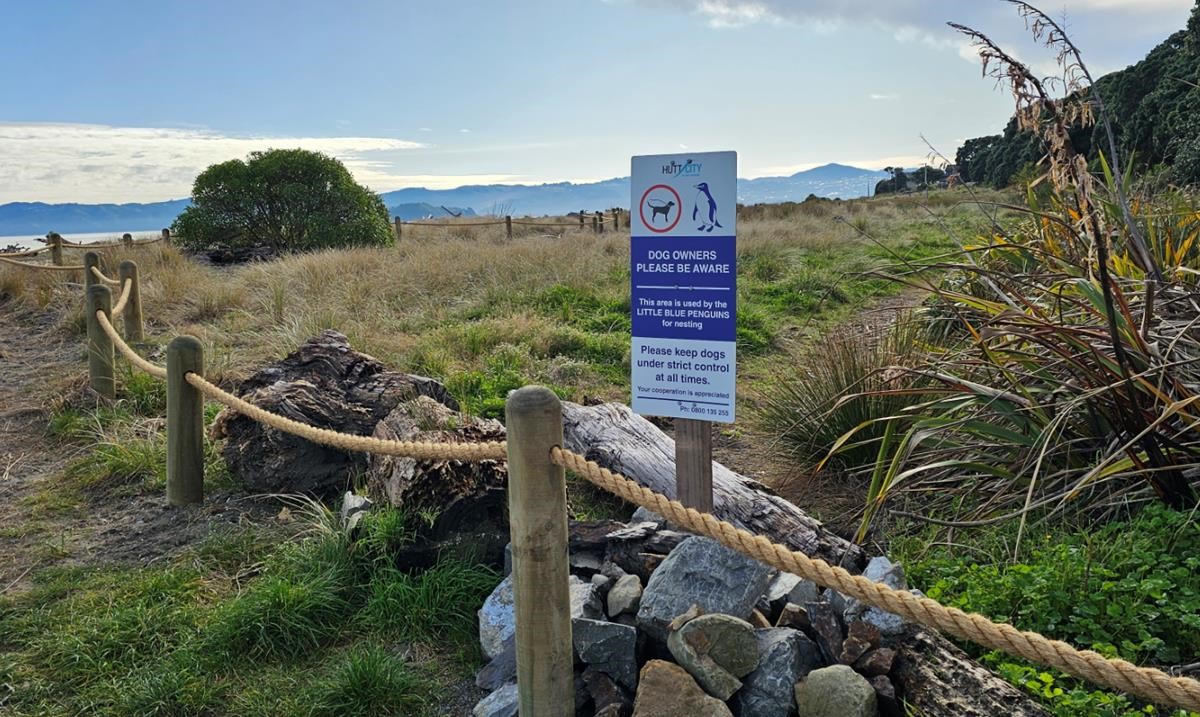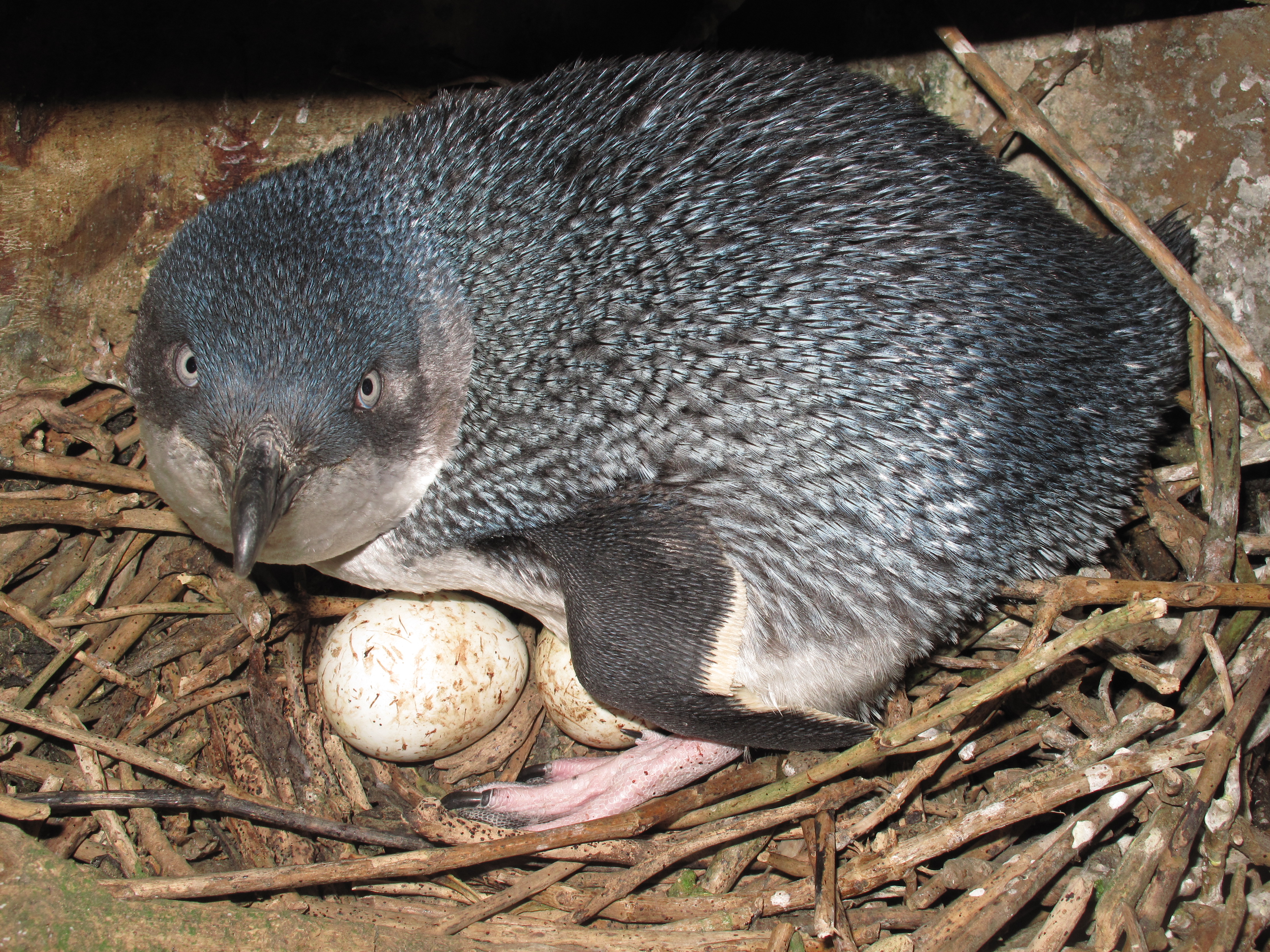Bird Protection Areas
Bird Protection Areas have been established at Whiorau Reserve, Bishop Park, HW Shortt Park and a small area of rock in Sorrento Bay as part of the consent conditions for the Tupua Horo Nuku project. These areas provide nesting opportunities for kororā (little blue penguins) and protect the nesting sites of tōrea pango (variable oystercatchers) and other native seabirds that may be displaced due to construction.
The Bird Protection Area in Whiorau Reserve includes a 1.2m high wooden fence to separate the road and the shared path from the Reserve and the kororā that live there. It will help prevent kororā from walking onto the road at night and it will help keep dogs on the path and out of the area.

The Bird Protection Area at CL Bishop Park will include a wooden fence along the dunes and a rope barrier along the walkways and on the seaward side. The fence will sit at the base of the rear dunes and have 40-50mm gaps between the palings to minimise the visual impact while also meeting the consent conditions.
The walkway along the dunes will be kept as is and three gates will allow access through the roped-off bird protection area.
Construction of the fence is due to begin Monday 5 August. We are working with Greater Wellington’s ecologists to avoid potential harm to penguins during construction.
Weed control work happened in July to control marram grass and contractors will return during the fence construction to finish spraying a small area of dunes. The contractors will use a targeted approach to the spraying and clearly signpost the sprayed area.
Dune restoration will begin once the fence is complete with the reintroduction of native species and up to 60 kororā/little penguin nesting boxes.
The BPA and beach area in front are prohibited for dogs. Dogs can be walked on leash outside the BPA and taken off leash at the dog exercise area south of Rona Bay wharf.

A Bird Protection Area has been established along the foreshore in front of HW Shortt Park. It includes the following:
- Signage identifying the area as nesting habitat
- Penguin nest boxes
- The timber fence between the foredune area and the park has been repaired and upgraded.
- A suspended rope barrier along the seaward perimeter
- Additional predator traps

Weed control work will be completed in March 2024 and planting of native species throughout the nesting habitat and foredune area will take place in June 2024 to continue the restoration work already completed and build on the legacy of the Eastbourne Dune Group.

The Sorrento Bay Bird Protection Area includes an area of 200 m2 of rocky foreshore that has been identified as being a known breeding site for at least one pair of tōrea pango/variable oystercatchers.
Specific elements of the design include:
- a fence (to be built 2026) to keep dogs out and screen breeding oystercatchers and their young from people using the shared path
- traps targeting key predators of the oystercatchers (mustelids, hedgehogs and rats)
- information boards describing the biology, life cycle and threats of/to these birds, as well as signs advising of the presence of nesting oystercatchers.
Changes to dog access
We’ve made changes under the Dog Control Bylaw which include prohibiting dogs from Bird Protection Areas (BPAs) at Sorrento Bay, Whiorau Reserve, CL Bishop Park and HW Shortt Park.
They also include prohibiting dog access at Sorrento Bay and the beach adjacent to CL Bishop Park, and removing the daylight-saving dog restriction at Whiorau Reserve. Dog access at HW Shortt Park outside of the BPA remains unchanged.
Dog owners can still exercise their dogs off-leash on the beach south of Rona Bay wharf from Rata Street to Miro Street. Dogs can also be off-leash at Days Bay north of Days Bay wharf from 1 April to 30 November and between 7pm -10am from 1 December to 31 March.
See the indicative maps of dog prohibition areas below:



Protecting our native birds
The Eastern Bays coastline is home to protected native bird species including the little blue penguins (kororā) and the variable oystercatcher (tōrea pango). Protection of these birds and their habitat is an important part of the Tupua Horo Nuku project, with particular focus given to kororā - an at-risk bird species.
Kororā
An estimated 700 little kororā live in and around Wellington Harbour, with 60-70 estimated to be living along the Eastern Bays coastline. They come ashore at all times of the year but spend more time on land when they’re breeding and moulting between July to February, requiring protected areas to do so safely.
During our works and in the longer-term, we’re doing all we can to minimise risks to the kororā including:
- carrying out surveys to locate burrow sites before construction begins in each bay
- creating exclusion zones around any nests and moulting birds to signal no works can take place in those zones until the penguins leave of their own accord
- creating bird protection areas (BPAs) in Whiorau Reserve, Bishop Park and HW Shortt Park
- managing the risk of dogs to kororā by excluding them from the BPAs
- installing traps to manage pest animals in the BPAs
- placing warning signs around the BPAs to deter people and dogs from entering those spaces, as well as information boards outlining habitat requirements of/threats to kororā
- holding educational events and activities to increase public awareness of the kororā.

You can help protect our feathered friends by:
- keeping dogs on leads and considering training them to steer clear of birds
- never throwing plastic and rubbish into the sea, as well as picking up any you see on the beach or in the water
- joining local trapping groups to help control predators (go to miro.org.nz for more information)
- joining local planting groups to help revegetate natural habitats.
We have boxes for nesting kororā in the bird protection areas, so when you’re walking along the beach you can:
- check for kororā footprints and let the Department of Conservation (DOC) know if you see some. Contact DOC by phoning 0800 362 468
- talk to others and share information about the bird protection area
- contact DOC or a local veterinary clinic if you find a sick, injured or dead kororā.
Oystercatchers
Tōrea pango/variable oystercatchers also live along these shores. The Sorrento Bay bird protection area includes roughly 200 square metres that’s a known breeding site for these birds. We will construct a fence along part of this area to keep dogs out and screen breeding oystercatchers and their young from people using the shared path.
The implementation of a Pest Management Strategy will reduce the risk of tōrea pango/variable oystercatcher eggs and chicks being lost to predators. The erection of warning signage and interpretation panels, and the implementation of a public education campaign will also contribute to reducing levels of disturbance by both people and dogs.
Disturbance caused during the construction of shared path will be managed by carrying out pre-construction surveys to locate Tōrea Pango / Variable Oystercatcher eggs and chicks, and by creating an exclusion zone around any nests or chicks found.

As their name suggests, the kororā (little blue penguin) are the smallest species of penguin.
They are the most common species found around all coasts of New Zealand with an estimate 700 birds being right here in Te Whanganui-a-Tara.
Kororā are a medium blue to dark indigo-blue colour with white underparts. They come ashore annually to moult and during this period, dorsal surfaces may be pale brown while their hooked bill is dark grey and their legs and feet are off-white.
Males are slightly larger than females, with more robust bills and recently fledged young are bright blue dorsally, and markedly smaller than adults.
They are primarily nocturnal on land, returning to nesting areas at dusk congregating in small groups or 'rafts' offshore. Their traditional nests are in underground burrows, under vegetation, in crevices, between rocks or in caves however since people came onto the coastal scene, kororā have also taken to nesting under houses and boat sheds, in stormwater pipes, and stacks of timber.
They live up to their scientific name ‘eudyptula’ meaning 'good little diver', as they are excellent pursuit hunters in shallow waters and can ‘fly’ through water at speeds of up to 6km/per hour.

The tōrea pango/variable oystercatcher is ranked as “At Risk, Recovering” on a national scale and “Regionally Vulnerable” within the Wellington region under the New Zealand Threat Classification System.
There are an estimated 728 tōrea pango/variable oystercatchers in the Wellington region, the vast majority of which are found on the coast, including the Eastern Bays. One breeding pair nests annually on a small offshore rock in Sorrento Bay.
They have a distinctive long, bright orange bill and coral-pink coloured legs. They are often seen in pairs probing busily for shellfish along beaches or in estuaries. They are long-lived, with some birds reaching 30+ years of age.
In the past, they were hunted for food and their population probably reached its lowest numbers in 1922, when protections were brought in. Since then, their numbers have increased rapidly. *
(New Zealand Birds online, n.d., https://nzbirdsonline.org.nz/species/variable-oystercatcher)
